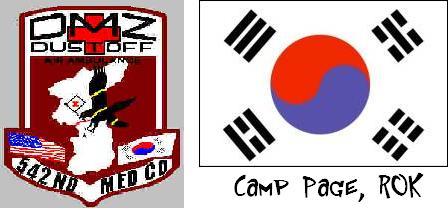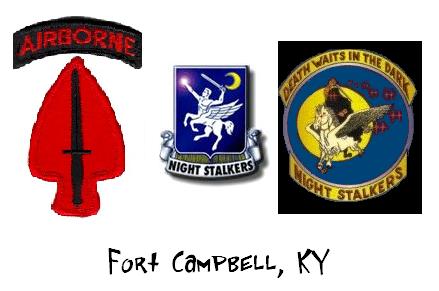 |
 |
 |
 |
 |
 |
Why would one join the Army?...
I joined the Army in 1995. Basic training was at Fort Jackson in South Carolina. After that I moved on to Fort Eustis, Virginia for AIT (Advanced Individual Training). This is where a soldier will learn his career field tasks. For me, I learned about the H-60 Blackhawk helicopter, the standard medium utility helicopter. This was my first aviation job, and was not to be my last!
Click here to learn about the history of my specific units!

After AIT, I moved to Hunter Army Airfield in Savannah, GA. At the time, it was the home of the Aviation Brigade for the 24th Infantry Division (Mechanized). Later we changed to 3rd ID (M) when the Army deactivated the 24th. (NOTE: the 3rd ID (M) was in Germany. They physically dissolved. However, when the Mary downsizes, it does so be eliminating the youngest unit of that type. So, the 24th, being the youngest Mechanized Infantry Division had to go. The unit in Germany is the one that actually disbanded, but our division took their name). So we went from 4/24th Aviation Regiment to 2/3rd Aviation Regiment. Either way, we were the armored component of the 18th Airborne Corps, America's rapid deployment force. During around three years I was at HAAF, I only spent one month at NTC (the National Training Center at Fort Irwin, CA). This is the base in the Mojave Desert that trains our nations military in desert warfare. Most of our training time, however, was spent in the pine forests of east Georgia. I also spent six weeks in the Caribbean doing drug interdiction.
"Goonybird" National Training Center Nov 1996 |
Formation Flying over Georgia 1995-1997 |
How to sleep in flight. Mr. Moore over Georgia. |
My job while at HAAF was a crewchief in the General Support platoon of C Company 2/3 AVN Reg. Charlie Company was often referred to (by me) as the miscellaneous company. While the other blackhawk companies were "lift" companies - meaning they existed to lift people and equipment from one place to another - we were made up of all the other aircraft essential a modern Mechanized Infantry Division. We had a platoon of scouts (flying OH-58's), a platoon of electronic warfare blackhawks (EH-60A), a platoon of Command and Control Blackhawks (aircraft fitted with communications and navigation gear to act as mobile command posts for Brigade Commanders), and us, General Support. Our job was to fly the three generals (DC - Division Commander, ADCM - Assistant Division Commander, Maneuver, and ADCS - Assistant Division Commander Support) any place, any time. We flew them around training areas, flew the ADCS back and forth between HAAF and Fort Stewart (the location of the ground fighter in the Brigade), as well as flying any visiting dignitaries on air tours of Fort Stewart. I have flow the Chinese military (Their equivalent of the Chairman of the Joint Chiefs), the Italian Defense Minister, the Sargent Major of the Army, and many others.
Sunset over Savannah |
Savannah River |
Big lighthouse on a little island. Bahamas |
It was during this time that we took our trips to Washington, DC and "discovered" Jacksonville, FL. Many people seem to love Savannah, but hose people never lived there. It's a filthy, old, corrupt city. I look up to General Sherman, whom I consider the greatest general in modern warfare. The only fault I saw in his military career was burning down every city in Georgia, except Savannah. See our picture pages for photos of my time here. We also have picture of our trip to Washington, DC.

My next stop was Camp Page, Korea. This (at the time) was home to 2nd ID's attack Battalion and the 542nd Medical Company (Air Ambulance). Our job was to provide air ambulance service to the DMZ, the zone separating North and South Korea. According to treaty, our aircraft had broad, yellow stripes on the tail, to distinguish us as allowed to fly into the DMZ. To do this, we have one aircraft and one crew on standby at the Hospital at all times. A second crew and aircraft is kept on a short leash back at base also. Once I do remember the first crew on one occasion calling up the second after flying nearly non-stop for over twelve hours. Normally, however, it was much less exciting. You would spend four days at the hospital eating, laying video games, and planning pranks on the relief crew.
Welcome to Camp Page. Population 500 |
Flying over Souel |
Keep off the grass. |
Standing next to one of our Blackhawks. |
I got one of the pilots to get a picture of me carrying a litter. Proof that I work! |
Standing next to one of our Blackhawks. (Again) |
We went to the field twice while there. Once we went, but the weather was horrible. So the ground crews went out in trucks, and we stayed behind with our helicopters. The day before the end of the exercise, we got weather. We flew out, put up out tents. The next morning, we packed our tents up and flew home. That was the best field exercise ever. The second time we went out was fun also. After returning from a mission, we landed and found our comrades engaged in a mock battle with each other. Our First Sargent had her video camera out and was filming to whole thing. Meanwhile, this one soldier had two prisoners. He was telling them to lie down. One of the guys kept trying to stand back up (screwing with the guy - remember, we all know each other) So one of my pilots starts yelling, "SHOOT HIM!" "GET DOWN," he yells. (Guy tries to get up) "SHOOT HIM!" the pilot yells. This goes on for a couple of minutes, then BANG! There we go. We had to have a big legal discussion on when a person becomes a prisoner. Our view was that if he's fighting back, he's not a prisoner. But we all had a good laugh, the pilot got in trouble, the First Sargent has to tape over her tape, all in all, a good day training.
| > | |||
This is what a sling load looks from all angels. Approach, the hook-up, and departure. |
|||
Flying the DMZ |
Give a Joe a giant bundle of camo, and this happens. |
||
Other than that, not much happened in Korea. Lot's of flying. Not much else.

After my return from Korea, I was reassigned to the 160th SOAR(A). (That's Special Operations Aviation Regiment - Airborne) Commonly known as the Nightstalkers, this unit flies H-6, H-47, & H-60 helicopters in support of special operations forces. They were formed after the failure of the Iranian hostage rescue attempt. The Army saw a need for an aviation unit that could perform long range missions under unusual circumstances. Interestingly enough, we also became a lightning rod for all the black helicopter lunatics out there who are sure that we are a bunch of murders that are hell-bent on destroying the country. They have been seen sitting outside the fence at Ft. Campbell, taking pictures as we fly off the end of the runway.
When one becomes a Nightstalker, they must pass through a selection course. Called CST (Combat Skills Training) or "Green Platoon," this four week school teaches medical skills, advanced weapons training, unarmed combat, & navigation skills. While awaiting the next school start date; you enjoy almost constant physical training. Running, push-ups, obstacle courses, ruck marches, etc. Every night you come home exhausted, sore, and, more often than not, covered in mud. After you complete CST, you will then go to another technical school about you airframe.
The rest of my tour at Fort Campbell was pretty uneventful. I was in the maintenance section, performing phase maintenance on H-60's. (Phase maintenance on Blackhawk helicopters is an inspection that takes place every 500 flight hours. The aircraft is basically taken apart and thoroughly inspected.) I spent mush of my time on call for the Army, but I did manage a trip to St Louis. It was in KY that Carmita discovered he love of Hummingbirds. We started with two feeders. Then we were told that the more feeders you have, the more comfortable the birds are, and the more you'll get. We had eight feeders at our peak, and filled them every other day! At times the birds swarmed like bees.
After my time was up at Ft. Campbell, I left the Army and moved near my wife's hometown in Northwest Florida.

















